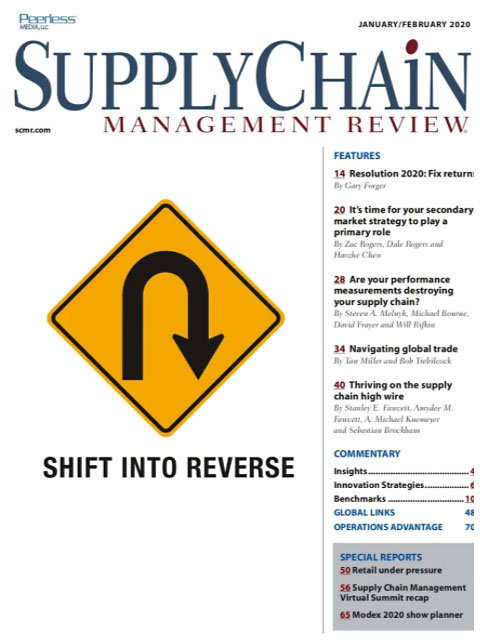Sorry, but your login has failed. Please recheck your login information and resubmit. If your subscription has expired, renew here.
January-February 2020
If the holidays at your household were like most, the gifts were chosen and wrapped with care, and then half were returned in the week after Christmas. Maybe more than half. After all, who among us hasn’t bought four shirts in a variety of sizes and colors with the intent of keeping one and returning three. And why not: Retailers and e-tailers alike have made returns seamless, easy and cheap. At least for the shopper. For the supply chains of the retailer, manufacturer or brand owner, returns are a once-neglected area that is growing into a major focus of supply chain managers who don’t want to see their organizations lose their shirt taking… Browse this issue archive.Need Help? Contact customer service 847-559-7581 More options
If you attended the most recent Reverse Logistics Association conference, you might have noticed two different sets of exhibitors. One set was marketing reverse logistics solutions and services to facilitate swift and efficient returns from customers who had second thoughts about the items they’d ordered. The other con-tingent was composed of salvage dealers, online auctioneers and software providers with solutions to help retailers and manu-facturers do a better job of recouping value from the returned goods.
They illustrated the two steps of the reverse logistics process: First, you have to develop efficient and cost-effective processes to get returned goods from wherever they were shipped back into your hands at your store, distribution center or to the 3PL man-aging your returns. Just as important is the second step: You have to dispose of those goods once they’re back in your control.
Without question, returns handling, the subject of the lead story in this issue of Supply Chain Management Review, has long been neglected by supply chain managers. But even more so has been that second step of disposition. In the past, many firms might have donated returned and over-stock items to charity or paid to have them sent to the landfill. The volumes weren’t large enough to justify a significant investment in the process. With the rise of e-commerce and the “Amazon-ification” of retail, that’s changing.

This complete article is available to subscribers only.
Log in now for full access or start your PLUS+ subscription for instant access.
SC
MR
Sorry, but your login has failed. Please recheck your login information and resubmit. If your subscription has expired, renew here.
January-February 2020
If the holidays at your household were like most, the gifts were chosen and wrapped with care, and then half were returned in the week after Christmas. Maybe more than half. After all, who among us hasn’t bought… Browse this issue archive. Access your online digital edition. Download a PDF file of the January-February 2020 issue.If you attended the most recent Reverse Logistics Association conference, you might have noticed two different sets of exhibitors. One set was marketing reverse logistics solutions and services to facilitate swift and efficient returns from customers who had second thoughts about the items they'd ordered. The other con-tingent was composed of salvage dealers, online auctioneers and software providers with solutions to help retailers and manu-facturers do a better job of recouping value from the returned goods.
They illustrated the two steps of the reverse logistics process: First, you have to develop efficient and cost-effective processes to get returned goods from wherever they were shipped back into your hands at your store, distribution center or to the 3PL man-aging your returns. Just as important is the second step: You have to dispose of those goods once they're back in your control.
Without question, returns handling, the subject of the lead story in this issue of Supply Chain Management Review, has long been neglected by supply chain managers. But even more so has been that second step of disposition. In the past, many firms might have donated returned and over-stock items to charity or paid to have them sent to the landfill. The volumes weren't large enough to justify a significant investment in the pro-cess. With the rise of e-commerce and the “Amazon-ification” of retail, that's changing.
SC
MR


Latest Supply Chain News
- Planning fatigue may be settling in
- Inflation, economic worries among top supply chain concerns for SMBs
- April Services PMI declines following 15 months of growth, reports ISM
- Attacking stubborn COGS inflation with Digital Design-and-Source-to-Value
- Despite American political environment, global geopolitical risks may be easing
- More News
Latest Podcast

 Explore
Explore
Topics
Procurement & Sourcing News
- Planning fatigue may be settling in
- Inflation, economic worries among top supply chain concerns for SMBs
- April Services PMI declines following 15 months of growth, reports ISM
- Despite American political environment, global geopolitical risks may be easing
- April manufacturing output slides after growing in March
- World Trade Centers offers a helping hand to create resilient, interconnected supply chains
- More Procurement & Sourcing
Latest Procurement & Sourcing Resources

Subscribe

Supply Chain Management Review delivers the best industry content.

Editors’ Picks






